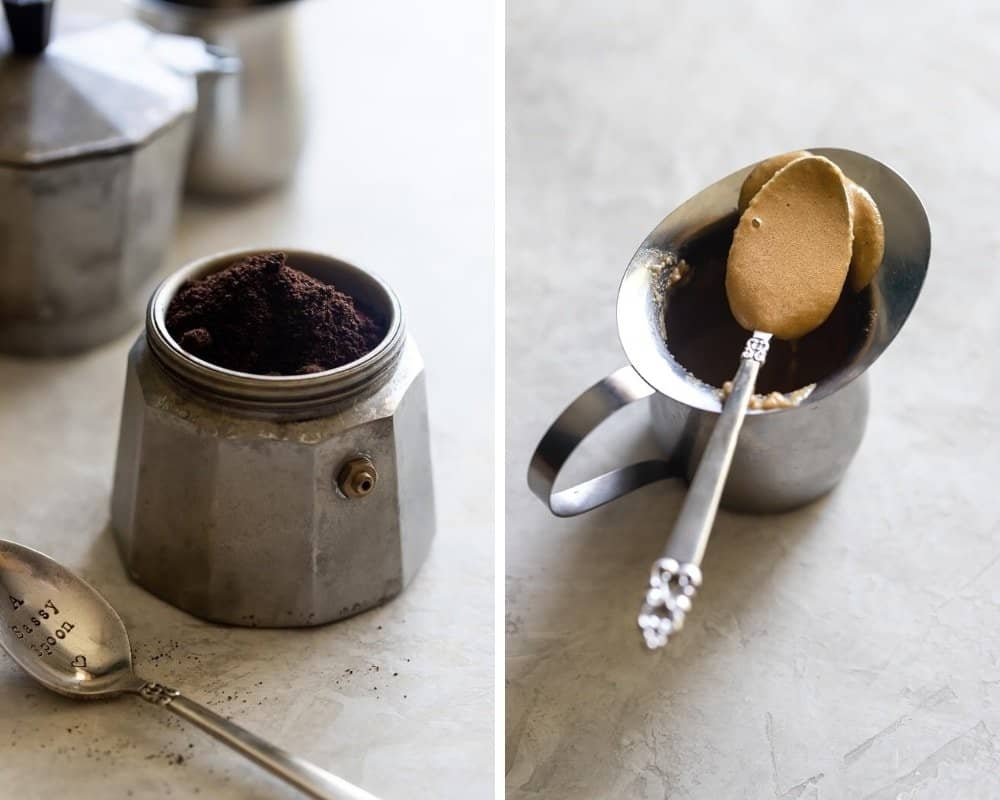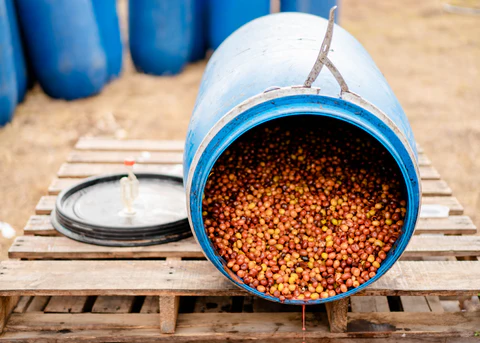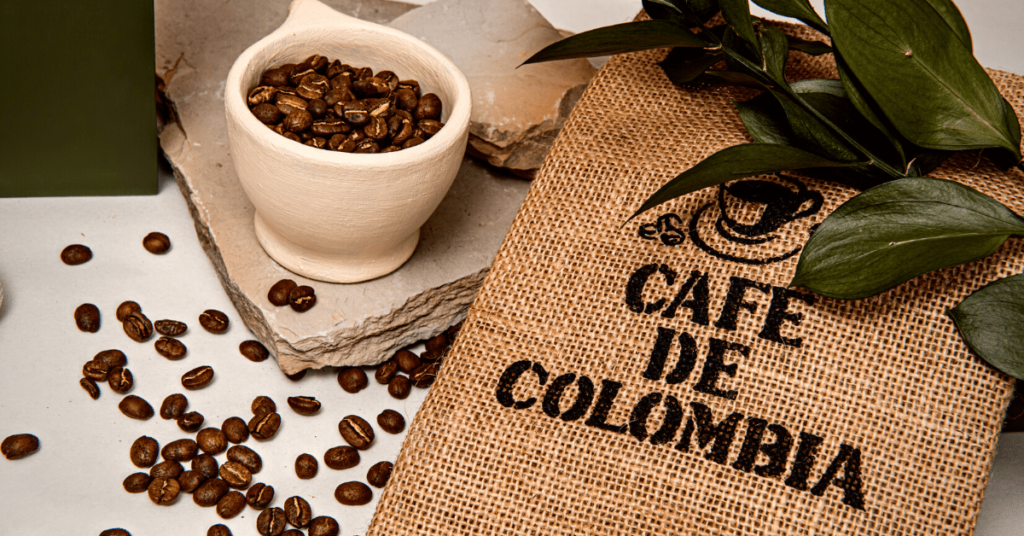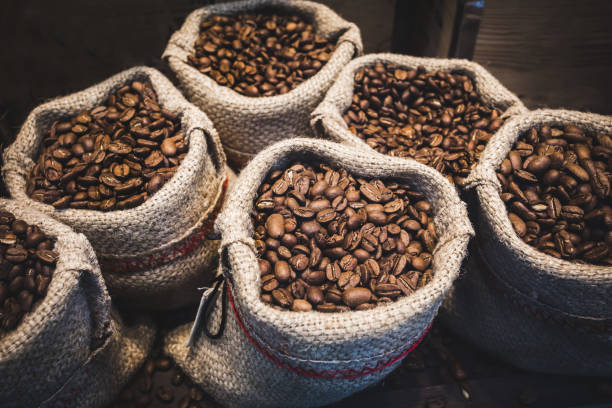Cuban espresso, or “cafecito,” is a unique and bold coffee that stands out due to its rich flavor and sweet, syrupy foam called “espuma.” This traditional Cuban coffee is an integral part of Cuban culture and is enjoyed at any time of the day. It’s not just about the caffeine kick; it’s about the ritual and the experience.
Cuban espresso is made using finely ground dark roast coffee, typically brewed in a stovetop espresso maker called a “cafetera” or “Moka pot.” The defining feature of Cuban espresso is the espuma, which is created by whipping the first few drops of brewed espresso with sugar until it forms a creamy, frothy mixture. This mixture is then poured back into the rest of the espresso, resulting in a perfectly balanced cup of coffee with a distinctive sweet touch.
This guide is all about learning the skills on how to make Cuban espresso and becoming an expert in it. Let’s dive in!

Understanding Cuban Espresso
Cuban espresso, or “cafecito,” traces its roots back to the island nation of Cuba. Coffee was introduced to Cuba in the mid-18th century and quickly became a staple of Cuban culture. Today, the cafecito is more than just a beverage; it’s a symbol of hospitality and social interaction. Sharing a cup of Cuban espresso is a cherished tradition, often enjoyed with friends and family as a sign of warmth and camaraderie.
What sets Cuban espresso apart from other coffees is its unique preparation method and the inclusion of “espuma,” a frothy, sweet foam. Unlike typical espresso, which relies solely on the coffee’s natural flavors, Cuban espresso incorporates sugar directly into the brewing process. The first few drops of the potent brew are vigorously mixed with sugar to create the espuma, which gives the coffee its characteristic sweet and creamy texture.
The cultural significance of Cuban espresso is deeply embedded in daily life. It’s not just a drink; it’s a ritual. From the bustling streets of Havana to the quiet corners of Cuban homes, the act of making and sharing a cafecito is an integral part of Cuban heritage. This rich cultural backdrop, combined with its distinctive taste, makes Cuban espresso a unique and beloved coffee experience.

Key Ingredients for Cuban Espresso
To make an authentic Cuban espresso, you’ll need a few specific ingredients that are crucial for achieving its distinct flavor and texture. Here’s what you’ll need:
1. Dark Roast Coffee Beans: The foundation of a good Cuban espresso is high-quality, finely ground dark roast coffee beans. Traditional Cuban coffee brands like Café Bustelo, Pilon, or La Llave are commonly used and are known for their robust flavor and rich aroma. The coffee should be ground to an espresso-like fineness to ensure a strong and concentrated brew.

2. Sugar: The signature sweetness of Cuban espresso comes from sugar, specifically granulated white sugar. It’s used to create the espuma, giving the coffee its unique frothy and sweet character. The amount of sugar can be adjusted based on personal preference, but typically, about one to two teaspoons per shot of espresso is standard.

3. Water: While often overlooked, the quality of water can significantly impact the taste of your espresso. Using filtered water helps maintain the purity of flavors in your coffee.

Equipment You Need
To make a perfect Cuban espresso, having the right equipment is just as important as the ingredients. Here’s a breakdown of the essential tools you’ll need:
1. Moka Pot (Cafetera): The traditional method for brewing Cuban espresso involves using a stovetop espresso maker, commonly known as a Moka pot or cafetera. This device is designed to brew coffee by passing boiling water pressurized by steam through the ground coffee. It’s a staple in Cuban households and is essential for achieving the authentic taste.

2. Demitasse Cups: Cuban espresso is typically served in small, espresso-sized cups known as demitasse cups. These small cups help concentrate the flavors and are perfect for enjoying the strong, sweet coffee.

3. Measuring Spoon: Accurate measurement of coffee and sugar is key to achieving the perfect balance of flavors. A measuring spoon ensures you use the right amount of each ingredient.

4. Mixing Cup or Bowl: To create the signature espuma, you’ll need a small mixing cup or bowl. This is where you’ll whip the first few drops of espresso with sugar to form the frothy, sweet foam.

5. Whisk or Spoon: A small whisk or spoon is used to vigorously mix the espresso and sugar to create the espuma. The more air you incorporate, the frothier and creamier your espuma will be.

Choosing the Right Espresso Maker
Selecting the right espresso maker is crucial for brewing an authentic Cuban espresso. While the traditional method involves using a Moka pot, there are other options available that can also deliver great results. Here’s a guide to help you choose the best equipment for your needs:

1. Moka Pot (Cafetera): The most traditional and widely used tool for making Cuban espresso is the Moka pot, also known as a cafetera. This stovetop espresso maker is affordable, easy to use, and produces a strong, rich coffee that’s perfect for Cuban espresso. It’s an excellent choice for anyone looking to recreate the authentic experience at home.
2. Espresso Machine: If you already own an espresso machine, it can be a great alternative for brewing Cuban espresso. Look for machines that allow you to control the pressure and temperature to ensure you get a consistent and robust shot of espresso. High-quality machines with a steam wand can also help you create the perfect espuma by frothing the sugar and espresso mixture.
3. AeroPress: Another versatile and portable option is the AeroPress. While not traditional, it can produce a strong, espresso-like coffee that works well for Cuban espresso. The AeroPress is particularly useful for those who travel or have limited kitchen space.
4. French Press: Although not ideal, a French Press can be used in a pinch. It won’t produce the same pressure as a Moka pot or espresso machine, but it can still deliver a strong brew. To get a more concentrated coffee, use a finer grind and increase the coffee-to-water ratio.
Step-by-Step Guide to Making Cuban Espresso
Making Cuban espresso at home is a straightforward process that involves a few key steps. Follow this comprehensive guide to brew a perfect cup of cafecito:
- Step 1: Grind the Coffee Beans Start with high-quality dark roast coffee beans. Grind them to a fine consistency, similar to espresso grind. This ensures the coffee extracts properly and delivers a rich, bold flavor.
- Step 2: Prepare the Moka Pot Fill the bottom chamber of your Moka pot with water up to the safety valve. Insert the filter basket and fill it with the freshly ground coffee. Level the grounds but avoid packing them too tightly.
- Step 3: Assemble and Heat Screw the top and bottom parts of the Moka pot together securely. Place the Moka pot on the stove over medium heat. The water will boil and create steam, which will push through the coffee grounds to brew the espresso.
- Step 4: Prepare the Espuma While the coffee is brewing, place 1-2 teaspoons of sugar in a small mixing cup or bowl. As soon as the first few drops of espresso begin to emerge, collect them in the cup with the sugar. Quickly return the Moka pot to the stove to continue brewing.
- Step 5: Whip the Sugar and Espresso Using a small whisk or spoon, vigorously mix the collected espresso and sugar until it forms a thick, frothy paste. This is the espuma, which gives Cuban espresso its characteristic sweet and creamy texture.
- Step 6: Combine and Serve Once the Moka pot has finished brewing, pour the remaining espresso into the cup with the espuma. Stir gently to combine. Pour the finished Cuban espresso into demitasse cups and serve immediately.
- Step 7: Enjoy Enjoy your homemade Cuban espresso. Whether you’re savoring it alone or sharing with friends and family, this rich and sweet coffee is sure to delight.
Grinding Your Coffee Beans
The grinding process is crucial for achieving the optimal flavor extraction in your Cuban espresso. The texture and consistency of your coffee grounds play a significant role in how well the coffee brews and tastes. Here’s how to get it just right:

- 1. Choose the Right Coffee Beans and Grind Size: For Cuban espresso, a fine grind is essential. The coffee grounds should be finer than table salt but not as powdery as flour. This fine texture allows for a quick extraction, producing a rich and bold flavor.
- 2. Use a Burr Grinder: To achieve a consistent grind size, use a burr grinder instead of a blade grinder. Burr grinders crush the beans uniformly, ensuring that all the coffee grounds are the same size. This consistency is key for even extraction and optimal flavor.
- 3. Freshness Matters: Grind your coffee beans just before brewing to maintain their freshness and aroma. Pre-ground coffee loses its flavor over time, so grinding your beans right before making your Cuban espresso will yield the best results.
- 4. Measure Carefully: Use the right amount of coffee for your Moka pot. Typically, you’ll need about one to two tablespoons of coffee per cup of water. Adjust the amount based on your taste preference and the size of your Moka pot.
- 5. Check the Texture: After grinding, feel the coffee grounds between your fingers. The texture should be fine and slightly gritty, similar to granulated sugar. If the grind is too coarse, the coffee will be weak and under-extracted. If it’s too fine, it can clog the Moka pot and result in a bitter brew.
Brewing Techniques
Mastering the brewing process is key to achieving the perfect Cuban espresso. Here are some essential techniques to help you brew a rich, flavorful cup of cafecito:

- 1. Use Fresh, Cold Water: Start with fresh, cold water when filling the bottom chamber of your Moka pot. Using filtered water can improve the taste of your espresso by reducing impurities.
- 2. Preheat the Water: For a smoother brew and to prevent the coffee from overheating, you can preheat the water before adding it to the Moka pot. This helps speed up the brewing process and reduces the risk of a burnt flavor.
- 3. Pack the Coffee Properly: Fill the filter basket with finely ground coffee, leveling it off without pressing it down. Over-packing can cause excessive pressure buildup and uneven extraction.
- 4. Control the Heat: Place the Moka pot on the stove over medium heat. Using too high of a heat can cause the coffee to brew too quickly, leading to a bitter taste. A moderate heat allows for a steady, even extraction.
- 5. Listen for the Gurgle: As the water in the bottom chamber heats up, it will start to boil and create steam pressure. You’ll hear a gurgling sound as the espresso begins to flow into the upper chamber. When this sound becomes more pronounced, it means the brewing process is almost complete.
- 6. Remove from Heat: Once you hear the gurgling sound indicating that most of the water has moved through the coffee grounds, remove the Moka pot from the heat. This prevents the coffee from overheating and developing a burnt flavor.
- 7. Create the Espuma: As the first few drops of espresso emerge, collect them in a cup with sugar to create the espuma. Mix vigorously until you achieve a thick, frothy consistency.
- 8. Combine and Stir: Pour the rest of the brewed espresso into the cup with the espuma and stir gently to combine. This ensures that the sweet, creamy foam is evenly distributed throughout the coffee.
Adding the Perfect Amount of Sugar
One of the defining features of Cuban espresso is its signature sweet flavor, achieved through specific sugar sweetening techniques. Here’s how to add sugar perfectly to create that authentic taste:

- 1. Use Granulated White Sugar: The traditional sugar used in Cuban espresso is granulated white sugar. Its fine texture dissolves easily and helps create the thick, sweet espuma that defines the drink.
- 2. Measure the Sugar: Typically, you’ll need about one to two teaspoons of sugar per shot of espresso. Adjust the amount based on your personal preference for sweetness. For a standard Moka pot, this usually means two to four teaspoons.
- 3. Collect the First Drops of Espresso: As the espresso starts to brew, collect the first few drops in a small mixing cup. These initial drops are the most concentrated and hot, which helps in dissolving the sugar quickly.
- 4. Create the Espuma: Add the measured sugar to the mixing cup with the first drops of espresso. Using a small whisk or spoon, vigorously whip the mixture until it forms a thick, frothy paste. The goal is to incorporate as much air as possible to create a creamy, sweet espuma.
- 5. Combine and Stir: Once the espuma is ready, pour the rest of the brewed espresso into the cup with the espuma. Stir gently to ensure the sweet foam is evenly distributed throughout the coffee.
- 6. Taste and Adjust: After mixing, taste your Cuban espresso. If it’s not sweet enough, you can add a little more sugar and stir again. The key is to find the perfect balance that suits your taste.
Tips and Tricks for the Best Cuban Espresso
- Use Fresh Beans: Freshly roasted dark roast beans provide a richer, more aromatic brew.
- Preheat Water: Preheating water avoids a burnt taste and ensures a smoother brew.
- Don’t Overpack: Level coffee grounds without pressing too firmly to avoid bitterness.
- Adjust Grind Size: Experiment with grind size for desired strength and smoothness.
- Use Filtered Water: Filtered water enhances flavor by reducing impurities.
- Stir Thoroughly: Stir espresso with espuma gently for consistent flavor.
- Serve Immediately: Enjoy fresh to preserve rich flavor and creamy texture.
- Experiment with Sugar: Try different sugars or sweeteners for varied flavors.
- Clean Equipment: Regular cleaning prevents buildup and maintains taste.
How to Serve and Enjoy
Serving Cuban espresso is an art in itself, enhancing the overall experience and enjoyment of this rich, sweet coffee. Here are some suggestions on how to serve and savor your Cuban espresso, along with pairing ideas to complement its bold flavors:

- 1. Serve in Demitasse Cups: Cuban espresso is traditionally served in small, espresso-sized demitasse cups. These cups help concentrate the flavors and are perfect for the small, potent servings that define Cuban espresso.
- 2. Warm the Cups: Before pouring your espresso, warm the demitasse cups by rinsing them with hot water. This helps maintain the coffee’s temperature and enhances the overall experience.
- 3. Pair with Sweet Treats: Cuban espresso pairs wonderfully with sweet treats. Traditional pairings include Cuban pastries like pastelitos, which are filled with guava, cheese, or coconut. The sweetness of the pastries complements the bold flavors of the espresso.
- 4. Enjoy with Friends and Family: Sharing a cafecito is a social tradition in Cuban culture. Serve your Cuban espresso to friends and family to create a warm, inviting atmosphere. It’s a perfect way to enjoy a small, flavorful break together.
- 5. Offer Water on the Side: Serving a small glass of water alongside the espresso helps cleanse the palate, allowing you to fully appreciate the rich flavors of the coffee.
- 6. Try Different Variations: While the classic Cuban espresso is delicious on its own, you can experiment with variations. Add a splash of milk for a cortadito, or use the espresso as a base for a café con leche by mixing it with steamed milk.
- 7. Embrace the Ritual: The process of making and serving Cuban espresso is as much about the ritual as it is about the drink itself. Take your time to prepare and enjoy the coffee, appreciating each step from brewing to sipping.
Common Mistakes to Avoid
Even with the best ingredients and equipment, these common mistakes can hinder the perfect cup of Cuban espresso. Here’s a quick rundown:
- Using Stale Beans: Always use freshly roasted beans to avoid flat, dull flavor. Learn about choosing the right coffee for unique recipes to achieve the best results.
- Incorrect Grind Size: Aim for a fine, espresso-like grind to avoid weak or bitter coffee.
- Overpacking the Filter: Level the grounds gently without packing them down to avoid bitterness.
- Using Tap Water: Use filtered water to avoid altering the coffee’s taste.
- Brewing at High Heat: Use medium heat for a slow, even extraction to avoid bitterness.
- Neglecting the Espuma: Mix the first drops of espresso with sugar vigorously to create a thick, creamy foam.
- Ignoring Cleaning: Regularly clean your Moka pot to prevent taste-altering residues.
- Inconsistent Measurements: Use measuring spoons for accurate coffee and sugar amounts.
- Serving in Cold Cups: Warm your cups to maintain the espresso’s temperature and flavor.
- Rushing the Process: Take your time with each step for the best results.

FAQs About Making Cuban Espresso
For an authentic Cuban espresso, use dark roast coffee beans. Brands like Café Bustelo, Pilon, and La Llave are traditional choices known for their bold and rich flavors.
Bitterness can result from over-extraction, using stale beans, or brewing at too high a temperature. Ensure you use fresh, finely ground coffee, a medium heat setting, and avoid overpacking the filter basket.
To make your Cuban espresso less strong, you can use slightly less coffee or a coarser grind. Additionally, you can add a bit of hot water to dilute the strength after brewing.
After each use, disassemble the Moka pot and rinse all parts with warm water. Avoid using soap as it can leave a residue. Dry all parts thoroughly before reassembling.
Disclosure: Our blog contains affiliate links to products. We may receive a commission for purchases made through these links. However, this does not impact our reviews and comparisons. We try our best to keep things fair and balanced, in order to help you make the best choice for you.






2 Responses